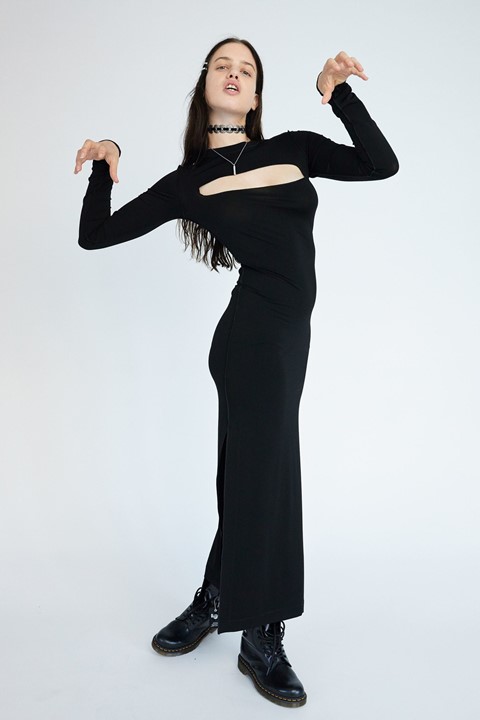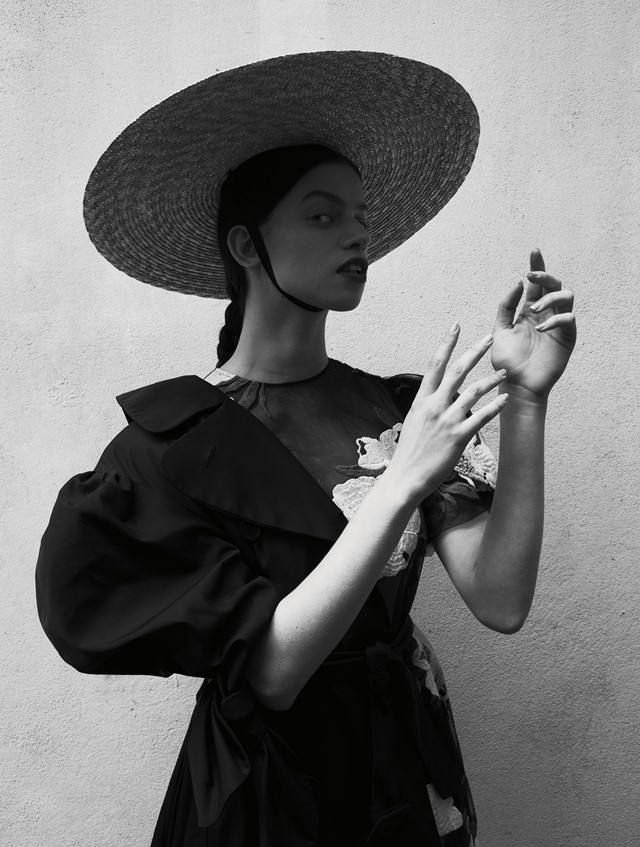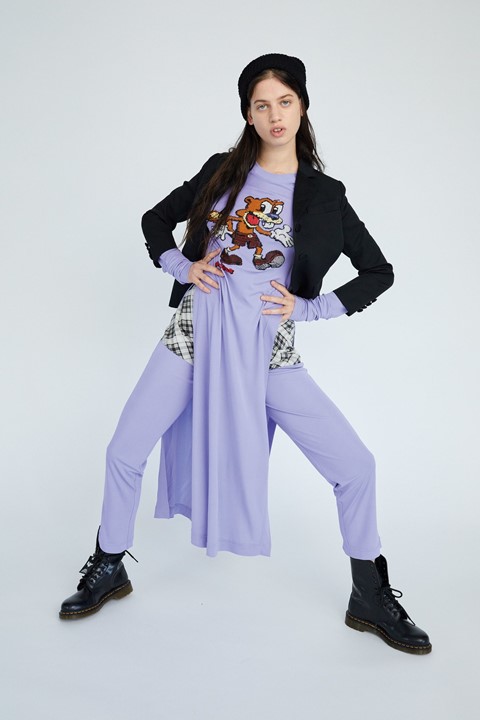In her latest edition of SEXNESS, AnOthermag.com columnist Lucy Kumara Moore speaks to model, actor and dancer Lily McMenamy about wearing latex and working with Juergen Teller
SEXNESS is a new monthly column exploring the shape of 21st-century desire from Lucy Kumara Moore, director of Claire de Rouen bookshop. A drive from the deep, a contested ground, a spur to our true identity, desire is manifold. Without aiming to be comprehensive, SEXNESS interweaves conversations with friends and personal perspective, to generate a PLEASURE-POSITIVE transmission from the cultural now.
I first encountered Lily McMenamy dancing wildly and with self-possessed originality in a one-woman performance, which served to present to a cliquey audience the new Symonds Pearmain collection in February 2017. It was clear that not only did she understand the finer points of this brand’s conceptual approach to fashion, but knew how to translate them into gesture and expression – no easy feat. I swooned! Since then, I see her everywhere, and admire her bold beauty, intelligent wit and true individuality. After last month’s column on the sensuality of clothes, I wanted to talk to Lily about latex – the way it makes you feel, the way it looks. I’d noticed her wearing it in a few shows and shoots, and thought she would have an interesting perspective. And of course, I was right...
Lucy Kumara Moore: So, just to explain a little, I was asked by AnOther if I wanted to write a column earlier this year, and I decided to use it to explore desire and pleasure in our time, from a personal perspective, as a kind of insurance against the desexualising effects of #MeToo.
Lily McMenamy: That’s good, you’re like the clever Carrie Bradshaw of art and fashion! I was just watching Sex and the City and Carrie was talking about the way women feel the need to be rescued by men. I thought ‘well I went to a feminist school, I’m not like that’, but actually I sometimes do fall into that train of thought and it freaks me out.
LKM: That’s the thing, when you admit to reality, things can be very different from the ideal. I am pregnant right now and there’s nothing that has convinced me more of the difference between men and women.
LM: I want to de-program myself.
LKM: We have to generate more understanding between us all, but I question whether we’ll get anywhere by saying gender doesn’t exist.

LM: I do agree with that.
LKM: We objectify each other naturally, men objectify women and women objectify men, but I think it’s possible for it to be done in a nuanced way that doesn’t disempower. And there’s a huge difference between respectful desire or flirtation and violent acts of harassment or abuse. Sometimes I think that distinction is ignored in soundbite debate.
LM: What I find most insidious is how a woman can swallow the male gaze and start to look at herself from that angle. It stops you from leading a fully embodied life. And that’s not the man’s fault per se, it’s society’s fault. One has to sort it out for themself.
LKM: So anyway... in my last column, I started thinking about the difference between clothes that are meant to look sexy but don’t make you feel sexy. And vice versa.
LM: While I was doing the dishes just now I was thinking about sexiness and modelling, which are completely tied because you’re meant to be attached to this object that you’re selling. Modelling started off as linked to prostitution, where you presented clothes and then you were expected to go home with the client, the buyer. Then they had to repackage that so they made it sanitised and that’s where photography comes in and its hygienic image of women. There’s no nasty, real female sexuality. It’s very ‘in the box’. I know you wanted to talk about latex which is a kind of sexual paraphernalia but backstage it’s the most horrifically unsexy, stressful thing to have to put on.
LKM: But once it’s on it’s amazing.
LM: It’s like a second skin! But I don’t feel sexual. It feels almost like I become a demon. I want to move like a spider.
“It’s like a second skin! But I don’t feel sexual. It feels almost like I become a demon. I want to move like a spider” – Lily McMenamy
LKM: I think latex is interesting because it works in two ways. It completely transforms the body…
LM: It covers you and exposes you at the same time.
LKM: It has an artificialising effect. In a way you become like a doll, just an outline, a piece of plastic, latex hides the aberrations of the body, you can’t see fat really, or hair. So it’s extremely objectifying in one way.
LM: It’s that pre-packaged, non-genuine sexuality I was talking about, you’re like a clean robot.
LKM: But then on the other hand the heightened sensation is amazing.
LM: That’s true. I’ve never worn it for me, personally, it’s always been on a shoot. Some pissed-off fashion assistant covering his hands in lube or trying to get flour down my legs. And then all those air bubbles! It’s just so traumatic. So maybe I need to heal all of that and wear it for myself.
LKM: Hahaha – only if you want to! You’ve done some work that is very overtly sexual. How did that aspect of what you do emerge and what do you think about being photographed in this way?
LM: Do you think I look very sexual in my photos?

LKM: Well, yeah! I mean, an extreme version would be that picture of you made by Olivier Zahm for Purple (issue 25). You’re tied up and lying on the ground.
LM: Oh god, yeah I found the Polaroid he gave me of that yesterday, I’m going to burn it! That was me as a confused teenager seeking male approval. That was not something embodied or honest or something I’m proud of.
LKM: I think it’s really important to say and acknowledge. I’ve always been fascinated by Richard Kern, do you know his work?
LM: Young girls photographed in a sexual way?
LKM: Exactly. So, whenever I raise the reservations I have about what he does, the usual riposte is ‘oh but the girls want to be photographed’. But I’ve always thought that perhaps these girls will feel very different about that ‘choice’ when they’re older.
LM: Exactly, it’s about not being properly educated in that sense. Sexiness is a way to get respected or be on a par with men, which is really fucked up; sexiness as a gateway towards being accepted by society because you’re not allowed to depend on other less superficial qualities – because you’re taught that you should want to be Cheryl Cole.
LKM: Do you mostly work with the same photographers on an ongoing basis or are you open to exploring new collaborations? How do you make those choices?
“Sexiness is a way to get respected or be on a par with men, which is really fucked up; sexiness as a gateway towards being accepted by society because you’re not allowed to depend on other less superficial qualities” – Lily McMenamy
LM: No, I just go with the flow really. I mean Juergen [Teller] is one I think about a lot, I oscillate in the way I feel about what he represents – which could be thought of as the vision of a straight white privileged man. But at the end of the day he manages to harness my spirit and we have a genuine silent conversation when he’s photographing me. I find parts of myself that I hitherto did not know and I leave feeling really supercharged. So I think it can work if I’m focused on setting those boundaries and taking no shit and if I’m working with a photographer who respects that.
LKM: When I look at pictures of you, you look like you’re in control. Whether that’s the case or not, the appearance of control is valuable, because the image is a representation that goes out into the world and has an impact that is not necessarily yoked to the ‘real situation’ that enabled the construction of the image.
LM: Yeah, you need to create this shield of confidence, even if you don’t feel it. Fake it ‘til you make it. I was in Peru recently and they were like ‘don’t take any photos of us because it’s stealing our souls’ and I was like ‘yeah, I get it, I’ve got none left now!’
LKM: Your personality is so strong in the imagery you make with photographers or in shows you do, like Symonds Pearmain. The other thing I love is how fashion reaches such a massive audience, so much bigger than art. And how this huge audience for fashion might receive new ideas because of this thing they love, which on the surface is very shallow, lightweight. Perhaps the audience doesn’t immediately understand radicality, but the newness is still entering their brains! I was watching that yoga thing you did for i-D’s More Than A Model series, ‘Learn Yoga with Lily McMenamy’ and I read all the comments written by viewers confused by the irony of it, and I thought it was almost more powerful than if they’d ‘got it’ – because confusion makes people pause and think. To change things, you have to reach people, people who aren’t already converts.
LM: Even the art world who think they’re sort of above fashion. I met an artist the other day who sampled that video, put it into a soundscape. I was like yeah, ça va. It’s a really far-reaching video.
LKM: Hahaha. That video is groundbreaking.
LM: Groundbreaking right! I don’t think anything I ever do will ever live up to that.
LKM: Ooh, let’s wait and see!
